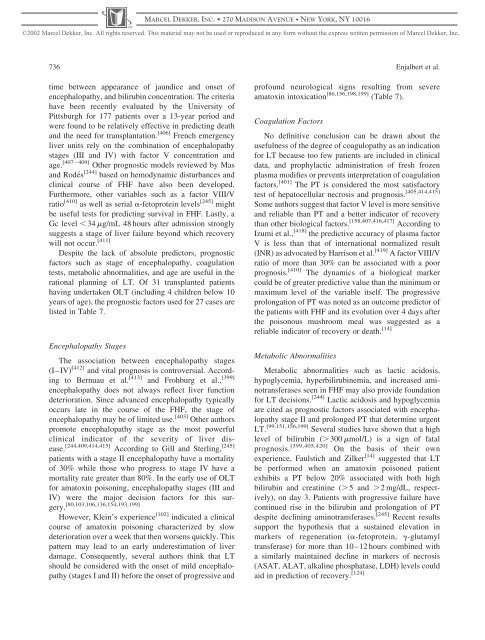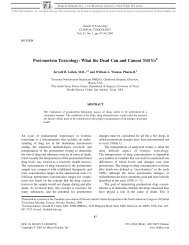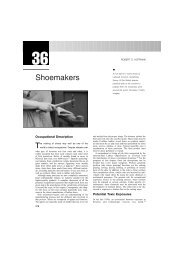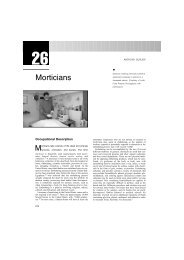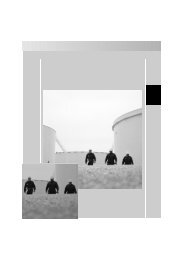9. Treatment of Amatoxin Poisoning-20 year retrospective analysis
9. Treatment of Amatoxin Poisoning-20 year retrospective analysis
9. Treatment of Amatoxin Poisoning-20 year retrospective analysis
You also want an ePaper? Increase the reach of your titles
YUMPU automatically turns print PDFs into web optimized ePapers that Google loves.
736<br />
time between appearance <strong>of</strong> jaundice and onset <strong>of</strong><br />
encephalopathy, and bilirubin concentration. The criteria<br />
have been recently evaluated by the University <strong>of</strong><br />
Pittsburgh for 177 patients over a 13-<strong>year</strong> period and<br />
were found to be relatively effective in predicting death<br />
and the need for transplantation. [406] French emergency<br />
liver units rely on the combination <strong>of</strong> encephalopathy<br />
stages (III and IV) with factor V concentration and<br />
age. [407 – 409] Other prognostic models reviewed by Mas<br />
and Rodés [244] based on hemodynamic disturbances and<br />
clinical course <strong>of</strong> FHF have also been developed.<br />
Furthermore, other variables such as a factor VIII/V<br />
ratio [410] as well as serial a-fetoprotein levels [245] might<br />
be useful tests for predicting survival in FHF. Lastly, a<br />
Gc level ,34 mg/mL 48 hours after admission strongly<br />
suggests a stage <strong>of</strong> liver failure beyond which recovery<br />
will not occur. [411]<br />
Despite the lack <strong>of</strong> absolute predictors, prognostic<br />
factors such as stage <strong>of</strong> encephalopathy, coagulation<br />
tests, metabolic abnormalities, and age are useful in the<br />
rational planning <strong>of</strong> LT. Of 31 transplanted patients<br />
having undertaken OLT (including 4 children below 10<br />
<strong>year</strong>s <strong>of</strong> age), the prognostic factors used for 27 cases are<br />
listed in Table 7.<br />
Encephalopathy Stages<br />
The association between encephalopathy stages<br />
(I–IV) [412] and vital prognosis is controversial. According<br />
to Bernuau et al. [413] and Frohburg et al., [399]<br />
encephalopathy does not always reflect liver function<br />
deterioration. Since advanced encephalopathy typically<br />
occurs late in the course <strong>of</strong> the FHF, the stage <strong>of</strong><br />
encephalopathy may be <strong>of</strong> limited use. [403] Other authors<br />
promote encephalopathy stage as the most powerful<br />
clinical indicator <strong>of</strong> the severity <strong>of</strong> liver disease.<br />
[244,409,414,415] According to Gill and Sterling, [245]<br />
patients with a stage II encephalopathy have a mortality<br />
<strong>of</strong> 30% while those who progress to stage IV have a<br />
mortality rate greater than 80%. In the early use <strong>of</strong> OLT<br />
for amatoxin poisoning, encephalopathy stages (III and<br />
IV) were the major decision factors for this surgery.<br />
[80,103,106,136,154,193,199]<br />
However, Klein’s experience [102] indicated a clinical<br />
course <strong>of</strong> amatoxin poisoning characterized by slow<br />
deterioration over a week that then worsens quickly. This<br />
pattern may lead to an early underestimation <strong>of</strong> liver<br />
damage. Consequently, several authors think that LT<br />
should be considered with the onset <strong>of</strong> mild encephalopathy<br />
(stages I and II) before the onset <strong>of</strong> progressive and<br />
MARCEL DEKKER, INC. 270 MADISON AVENUE NEW YORK, NY 10016<br />
©<strong>20</strong>02 Marcel Dekker, Inc. All rights reserved. This material may not be used or reproduced in any form without the express written permission <strong>of</strong> Marcel Dekker, Inc.<br />
pr<strong>of</strong>ound neurological signs resulting from severe<br />
amatoxin intoxication [86,156,198,199] (Table 7).<br />
Coagulation Factors<br />
No definitive conclusion can be drawn about the<br />
usefulness <strong>of</strong> the degree <strong>of</strong> coagulopathy as an indication<br />
for LT because too few patients are included in clinical<br />
data, and prophylactic administration <strong>of</strong> fresh frozen<br />
plasma modifies or prevents interpretation <strong>of</strong> coagulation<br />
factors. [401] The PT is considered the most satisfactory<br />
test <strong>of</strong> hepatocellular necrosis and prognosis. [405,414,415]<br />
Some authors suggest that factor V level is more sensitive<br />
and reliable than PT and a better indicator <strong>of</strong> recovery<br />
than other biological factors. [158,407,416,417] According to<br />
Izumi et al., [418] the predictive accuracy <strong>of</strong> plasma factor<br />
V is less than that <strong>of</strong> international normalized result<br />
(INR) as advocated by Harrison et al. [419] A factor VIII/V<br />
ratio <strong>of</strong> more than 30% can be associated with a poor<br />
prognosis. [410] The dynamics <strong>of</strong> a biological marker<br />
could be <strong>of</strong> greater predictive value than the minimum or<br />
maximum level <strong>of</strong> the variable itself. The progressive<br />
prolongation <strong>of</strong> PT was noted as an outcome predictor <strong>of</strong><br />
the patients with FHF and its evolution over 4 days after<br />
the poisonous mushroom meal was suggested as a<br />
reliable indicator <strong>of</strong> recovery or death. [14]<br />
Metabolic Abnormalities<br />
Enjalbert et al.<br />
Metabolic abnormalities such as lactic acidosis,<br />
hypoglycemia, hyperbilirubinemia, and increased aminotransferases<br />
seen in FHF may also provide foundation<br />
for LT decisions. [244] Lactic acidosis and hypoglycemia<br />
are cited as prognostic factors associated with encephalopathy<br />
stage II and prolonged PT that determine urgent<br />
LT. [99,151,156,199] Several studies have shown that a high<br />
level <strong>of</strong> bilirubin (.300 mmol/L) is a sign <strong>of</strong> fatal<br />
prognosis. [399,405,4<strong>20</strong>] On the basis <strong>of</strong> their own<br />
experience, Faulstich and Zilker [14] suggested that LT<br />
be performed when an amatoxin poisoned patient<br />
exhibits a PT below <strong>20</strong>% associated with both high<br />
bilirubin and creatinine (.5 and .2 mg/dL, respectively),<br />
on day 3. Patients with progressive failure have<br />
continued rise in the bilirubin and prolongation <strong>of</strong> PT<br />
despite declining aminotransferases. [245] Recent results<br />
support the hypothesis that a sustained elevation in<br />
markers <strong>of</strong> regeneration (a-fetoprotein, g-glutamyl<br />
transferase) for more than 10–12 hours combined with<br />
a similarly maintained decline in markers <strong>of</strong> necrosis<br />
(ASAT, ALAT, alkaline phosphatase, LDH) levels could<br />
aid in prediction <strong>of</strong> recovery. [124]


